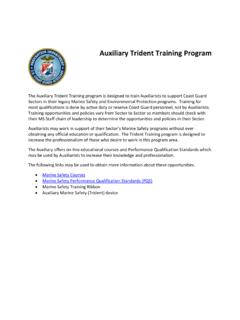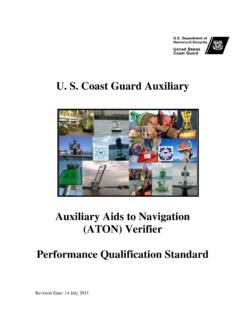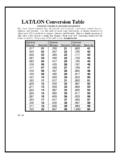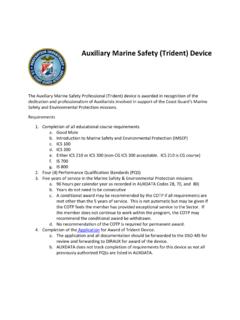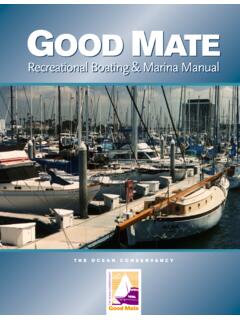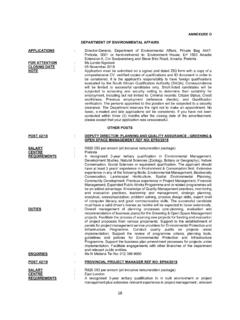Transcription of Introduction to Marine Safety - Welcome to the Prevention ...
1 Introduction to Marine Safety and environmental protection United States Coast Guard Deputy for Operations Policy and Capabilities (CG-DCO-D) office of Auxiliary & Boating Safety (CG-BCX) Coast Guard Auxiliary Division (CG-BCX-1) Coast Guard Auxiliary Prevention Directorate Revised: 19 April 2013 IMSEP 2 IMSEP 3 Introduction to Marine Safety and environmental protection ( Prevention ) modified 041913 Table of Contents Introduction and Learning Objectives Introduction Learning Objectives Review Questions and End of Course Exam Marine Safety Coast Guard Missions and Structure The Importance of Marine Safety Regulations and Enforcement The Marine Safety Program Marine Safety Manual (MSM) The Marine Inspection (MI) Program Port Safety and Security (PSS) Program. PSS Program Evaluation and Management.
2 Auxiliary Support for Coast Guard Marine Safety ( Prevention ) Programs Maritime Observation Mission (MOM) Container Inspection Support Support for Ferry and Small Passenger Vessel Inspections Examination of Commercial Towing Vessels (UTV) and Uninspected Passenger Vessels (UPV) America s Waterway Watch. IMSEP 4 Support for Regional Exam Centers and field visits to maritime training schools. Commercial Fishing Vessel Examinations (CFVEs) and Dockwalkers public affairs support. Development of training and qualifications standards and materials for Auxiliary members participating in Marine Safety programs and activities. Facility Inspections Domestic & Port State Inspections Investigations Auxiliary Trident Specialty areas in support of Marine Safety Programs. The Marine environmental protection (MEP) Program History.
3 Program Activities. Pollution Response Activities. Response Oversight. International Conventions. Coast Guard In-House Compliance with environmental Law. Marine Pollution Financial Responsibility and Compensation Activity. Auxiliary Support for Coast Guard Marine environmental protection and Response Programs Sea Partners and Officer Snook Education & Public Outreach Program Aquatic Nuisance Species (ANS) Mitigation IMSEP 5 The Good Mate Program National Clean Boating Campaign/Clean Vessel Act Support Clean Marina Program Support National Marine Debris Monitoring and Beach Cleanup Programs Marine Mammal Monitoring HAZMAT/HAZWOPER Education and Patrol Support Assistant Federal On-Scene Coordinator Representative and Assistant Pollution Response Specialist Marine Transportation Systems Management (CG-55) (formerly office of Waterways Management (CG-55).)
4 Program Objectives Programs Auxiliary Support for Coast Guard Waterways Management Program Maritime Observation Mission (MOM) Identification of Abandoned Vessels and Barges Local Harbor Safety Committees Support for the National Oceanic and Atmospheric Administration (NOAA) and the United States Army Corps of Engineers (USACE) with Chart Updating Auxiliary Bridge Administration Program ATONs and PATONS Recreational Boating Safety Program Mission History and Today Boat Responsibly IMSEP 6 Planning and Emergency Management Training and Familiarization with the Incident Command System (ICS) and Auxiliary requirements. Guidelines for Emergency Response Auxiliary Support to the Coast Guard for Local and Area Planning Cooperation and Team-Building with Local Emergency Response Organizations The Development of Field Training Exercises and Drills to Evaluate Emergency Preparedness Control and Enforcement Actions Flag State and Port State Responsibilities Vessel Categories Inspection Types Merchant Mariner Licensing Marine Investigations Sources of Authority Control and Enforcement Action Intervention and International Agreements Federal Laws and Regulations Definitions Legal and Regulatory Publications Coast Guard Guidance Occupational Safety and Health Framework Command Organization and Responsibilities IMSEP 7 Occupational Medical Surveillance and Evaluation Program (OMSEP)
5 Marine Safety Field Hazards Evaluating and Controlling Field Hazards Confined Space Safety Conduct and Ethics Standards of Ethical Conduct Professionalism Review Questions Appendix Web Links to: The Coast Guard S. Indianapolis The Sultana Answers to Review Questions IMSEP 8 Introduction to Marine Safety and environmental protection Introduction and Learning Objectives Introduction This course is designed to introduce members of Team Coast Guard Active Duty, Reserve, Auxiliary and Civil Service to the Marine Safety organization, history, missions, functions and programs of the United States Coast Guard. The course is intended primarily for non-resident training purposes. Taking advantage of its web based information each course component may be detached and updated independently. This insures that the course can be continuously updated as programs and organizations change and evolve over time.
6 Trainees and members will be required to have access to the internet to retrieve the numerous web documents referenced. The Introduction to Marine Safety and environmental protection end of course exam has questions from this document and many of these web resources. Coast Guard web pages on the Marine Safety Program. The US Coast Guard Historian, The Auxiliary Prevention Department, The Code of Federal Regulations (CFR) The United States Code (USC) Marine Safety Manuals (MSM) Learning Objectives Completion of this course will accomplish the following objectives. Acquaint the trainee with the history and organization of the Marine Safety and environmental protection functions of the Coast Guard. Provide the trainee an overview of the organization and content of Coast Guard Marine Safety and environmental protection programs. Provide the trainee a basic working knowledge of the Marine Safety Manual and the Code of Federal Regulations.
7 Provide a basic educational component for members working toward qualifications in Marine Safety and environmental protection and a first step in meeting the qualifications for the Trident and the Marine Safety Device. Satisfy member basic education requirements in Marine Safety and environmental protection and provide for member recognition and continuing education credit. IMSEP 9 Review Questions and End of Course Exam It is recommended that each student read and answer the review questions in order to be familiar with the substance as well as the format of questions that will appear on the end of course exam. There are questions taken directly from this document and questions that will require access to web pages referenced in the text. Students should not attempt the End of Course Exam unless they are able to pass the review questions with a score of 90%.
8 Answers to the review questions will be found in the Appendix. IMSEP 10 Marine Safety Coast Guard Missions and Structure Coast Guard Missions The Coast Guard is the principal federal agency charged with Maritime Safety , Maritime Security and Maritime Mobility. Additional Coast Guard missions include National Defense and protection of our Natural Resources. There are numerous Missions as shown below, assigned to the Coast Guard. This course will concentrate on two, Maritime Safety and protection of Natural Resources. Many of these mission-programs benefit more than one role, but each directly supports the roles of Safety , security and stewardship. Mission Program Maritime Safety Saving Lives and Protecting Property Marine Safety Search and Rescue Recreational Boater Safety Passenger Vessel Safety International Ice Patrol Port Security Maritime Security Establishing and Maintaining a Secure Maritime System while Facilitating its use for the National Good Illegal Drug Interdiction Alien Migrant Interdiction EEZ & Living Marine Resource General Maritime Law Law/Treaty Enforcement IMSEP 11 Maritime Mobility Aids to Navigation Icebreaking Services Vessel Traffic Services Bridge Administration Rules of the Road National Defense General Defense Duties Maritime Intercept Operations Deployed Port Operations and Security Peacetime Engagement environmental Defense Operations protection of Natural Resources Managing the Sustainable & Effective use of its Inland.
9 Coastal and Ocean Waters & Resources for the Future Marine and environmental Science Living Marine Resources protection Foreign Vessel Inspections Marine Pollution Education, Prevention , Response, and Enforcement Marine environmental protection IMSEP 12 Coast Guard Structure A. Sectors By the authority of the Commandant in 2006, the Coast Guard reorganized (see Organizational History) all field units including Marine Safety Offices, Groups, Vessel Traffic Services (VTSs), and in some cases Air Stations, having largely or entirely the same Areas of Responsibility (AORs) into Sector Commands. Sector Commanders are vested with all the rights, responsibilities, duties, and authority of a Group Commander and a Commanding Officer, Marine Safety office (MSO) as provided for in United States Coast Guard Regulations 1992, COMDTINST (series). B.
10 Sector Commanders carry out the Sector s missions as follows: 1. Captain of the Port (COTP) COMDTINST 1-2 2. Federal Maritime Security Coordinator (FMSC) when serving as COTP for an Area Maritime Security (AMS) Area pursuant to 33 CFR 3. Federal On-Scene Coordinator (FOSC) consistent with the National Contingency Plan 4. Officer in Charge, Marine Inspection (OCMI) 5. Search and Rescue (SAR) Mission Coordinator (SMC) C. Unified Command The tragic events of September 11, 2001, substantially altered recognition of security risks to Marine transportation similar to changes in environmental risk that were recognized as the result of major pollution incidents. This reinforced the importance of collaborative preparedness for incident management and need for a unified command construct that: 1. Improves mission planning execution and performance outcomes. 2. Increases interaction and coordination between operational commands and interagency partners.
